by Daniel Hathaway
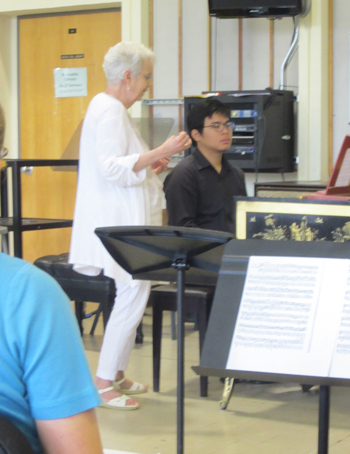
Performance No. 1 was a C-major prelude from the Wilhelm Friedemann Bach Notebook — a set of pieces Johann Sebastian Bach expressly selected for the tutelage of his eldest son beginning in 1720. Edwards began by asking what type of piece it was. Answer: a figuration prelude, in style brisé, which is meant to imitate the lute. In fact, Edwards said, the harpsichord is really a giant lute with keys. Advice to student: overhold notes (including octaves in the left hand), let the strings vibrate, and think of articulation in terms of wetness vs. dryness.
Performance No. 2 was a Gibbons Fantasia that the performer had already played for Crawford in a lesson — using a highly suspect modern edition:
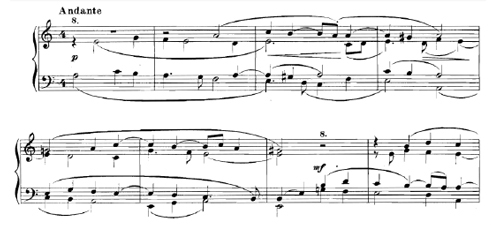
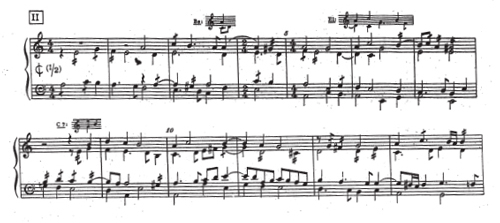
The last player delivered vibrant readings of Jacques Duphly’s La Victoire and La Felix. Crawford gave the performer, a pianist who had recently taken up the harpsichord, some tips about adjusting his technique accordingly. She also advised him to “let the piece breathe and bloom” — he always seemed to be thinking ahead to his next move.
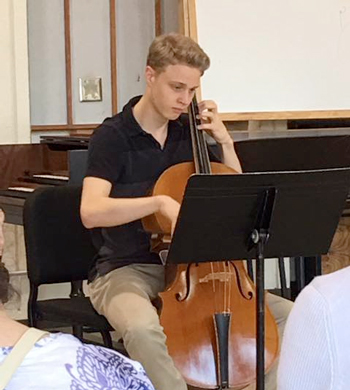
Stefanović is 17 and attends the Baltimore School for the Arts. His father is associate principal second violin in the Baltimore Symphony, having left his native Serbia to study at the Cleveland Institute of Music where he met his future wife, a cellist.
Luka’s older and younger siblings play viola and cello, and growing up in such a string-oriented family, I suggested it was inevitable that he’d take up a bow early in his life. “Actually, at the age of four, I wanted to play the trombone,” he said, “but my parents told me that my lungs weren’t developed enough to play a wind instrument. They said, ‘Why don’t you play cello? It’s close enough, and you can switch later.’ As you can see, I never did.”
Not every young cellist is drawn to early music. What led Luka in that direction? “I really enjoyed the sound of historical instruments, and my curiosity for what’s outside the mainstream fueled my interest. There’s almost nothing in the way of early music for high school-age students in Baltimore, or probably in any city.”
BPI represented Luka’s first complete immersion in the subject. “I had been replicating historical playing on my modern cello with a baroque bow, but it’s really not the same,” he said. “And the environment of BPI is vastly different from anything I could have here at home.”
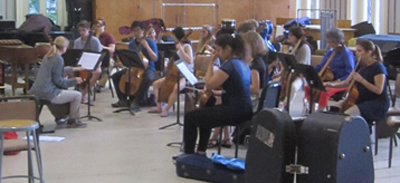
I asked Luka if he had any sense of why the gamba seems to inspire such ardent devotion among those who take up the instrument. “People always say the cello is closest to the human voice, but I would say that the gamba comes even closer,” he said. “If you’re going to spend your life playing it, you have to be completely devoted. It’s very difficult, and the repertoire is so vastly different from the cello.”
While his teacher, Daniel Levitov (himself an Oberlin graduate and BPI alumnus) isn’t a Baroque musician himself, Luka said he’s always fostered his interest in the subject. What were his expectations going into BPI? “I went in expecting a less-welcoming environment than it ended up being, which was fantastic,” he said. “I also expected to have a lot more time to practice. They keep you busy, which is good. I learned so much and the faculty is very knowledgeable. Having a master class with Ken Slowik every day was one of the high points. His anecdotes often go off-topic, but they’re still informative and interesting.”
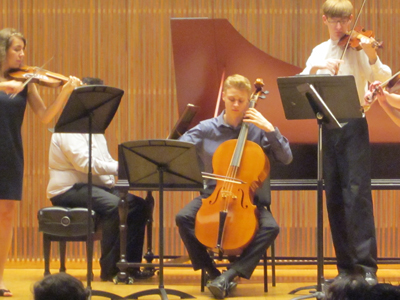
Luka Stefanović plans to attend a conservatory or university pursuing degrees in modern cello, adding Baroque cello wherever he can. “If it ends up that Baroque cello is taking more and more of my life, I can switch over. But I’d like to keep the two in equal balance.”
• • •
This afternoon, John Thiessen coached the final rehearsal of my chamber ensemble and we discussed the dress rehearsal plan for Saturday afternoon’s participant recital in Kulas Hall. Because his airline had switched him to an earlier flight on Saturday, this was the last opportunity to adjust details before a runthrough in the hall.
The second Friday evening concert, the bigger of the two, combined BPI faculty and advanced students into a 38-piece Baroque orchestra. “La Belle Danse,” curated by Skip Sempé, who conducted from the harpsichord, gathered dance movements from operas by Jean-Baptiste Lully, Marin Marais, and Georg Muffat into three suites.
Too bad there weren’t dancers available to flesh out the evocative music, but thanks to the vivid and elegant playing of the large faculty-student ensemble, you could close your eyes imagine Fauns and Driads (Alcyone), Magicians (La Pastorale Comique), and the great god Pan and his company — accompanied by violins and flutes enroute to the King’s table (Armide) — processing across the Warner Concert Hall stage. The orchestra played with assured ensemble, Sempé shaping phrases only with an occasional gesture from the keyboard.
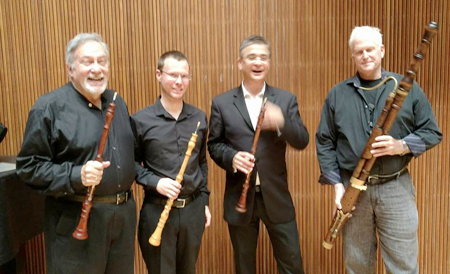
Particularly striking were the three inner movements “Harlequinade,” “Espagniol,” and “Sommeille,” the latter a theatrical slumber scene that ends with a naked low C from the violone. Speaking of the violone, it was satisfying to hear 16’ pitch in the continuo department during the Telemann. What did French Baroque composers have against doubling bass lines at the octave below?
Published on ClevelandClassical.com July 7, 2017.
Click here for a printable copy of this article


